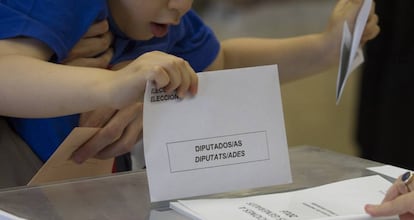Spain: one person, one vote?
Designed to prevent the cities from dominating politics, the country’s electoral system benefits a two-party system

Among the electoral requirements outlined by the Spanish Constitution are universal suffrage, freedom of choice, equality, and a direct and secret vote. But the Spanish system also produces a number of imbalances, notably that some votes carry more weight than others, depending on where in Spain they are cast. For a political party to secure a seat in Spain’s Congress, two plus two votes do not always add up to four, but instead can result in three, or eight. What’s more, this imbalance is built into the system.
Recent polls show that 80% of the population wants reform of Spain’s electoral system in order to give greater proportionality between the number of overall votes a party receives and the number of seats it wins in Congress, even if such a system makes it more difficult to form governments.
Based on the last general elections in December 2015, it should take around 72,000 votes for a party to win a seat in Congress: that’s 25.3 million votes divided by the 350 seats in Congress, give or take a few thousand. But in reality, only a dozen or so of Spain’s 50 provinces (plus the Moroccan exclaves of Ceuta and Melilla), actually operate on this basis. For example, Cadiz, where at the last poll, each of the nine representatives that won a seat in Congress garnered 72,246. At either end of the extreme, in Madrid a seat in Congress required 100,748 votes, while in the rural province of Soria, in north-central Spain, it was worth just 25,986 votes.
To prevent the country’s cities from dominating politics, the Spanish Constitution implemented major restrictions on proportional representation
How is it possible that votes in Soria are worth four times those in Madrid?
The problem is rooted in the proportional representation system that Spanish legislators set up in 1977 as the country returned to democracy after 40 years of dictatorship, and that was then implemented into law in 1985. A 1985 Constitutional Court mentions the “desire” to balance the number of votes a party wins with the number of seats it is awarded in Congress. Proportionality is thus understood more as a goal than a strict mathematical rule. And the party in power has the flexibility to decide just how proportional the vote is.
The thinking behind the decisions made almost four decades ago were aimed at balancing out Spain’s unbalanced demographics. To avoid marginalizing rural areas and to prevent the country’s cities from dominating politics, the Spanish Constitution implemented major restrictions on proportional representation, notably by establishing that each of Spain's 50 provinces is a constituency and entitled to an initial minimum of two seats, and that there would be between 300 and 400 seats in Congress. Boosting the weight of Huesca and Guadalajara at the expense of Madrid and Barcelona was seen as a way of balancing a demographic imbalance in terms of representation.
The effects of this imbalance have, until now, favored the two main parties, which have a strong presence in rural areas. But the appearance of two major new political forces at the national level makes it increasingly difficult to justify the system of the last four decades. The four main parties take 85% of the vote, with none able to garner more than 30% and none with less than 10%.
In the final analysis, it isn’t the D’hondt proportional representation system that is responsible for the imbalances of the Spanish electoral system per se, but instead its asymmetric application to Spain’s 52 constituencies. A certain amount of flexibility in establishing proportional representation is no bad thing, but in the case of Spain will require work to make the system fairer.
Francisco Camas García is an analyst at Metroscopia.
English version by Nick Lyne.
Sign up for our newsletter
EL PAÍS English Edition has launched a weekly newsletter. Sign up today to receive a selection of our best stories in your inbox every Saturday morning. For full details about how to subscribe, click here.
Tu suscripción se está usando en otro dispositivo
¿Quieres añadir otro usuario a tu suscripción?
Si continúas leyendo en este dispositivo, no se podrá leer en el otro.
FlechaTu suscripción se está usando en otro dispositivo y solo puedes acceder a EL PAÍS desde un dispositivo a la vez.
Si quieres compartir tu cuenta, cambia tu suscripción a la modalidad Premium, así podrás añadir otro usuario. Cada uno accederá con su propia cuenta de email, lo que os permitirá personalizar vuestra experiencia en EL PAÍS.
¿Tienes una suscripción de empresa? Accede aquí para contratar más cuentas.
En el caso de no saber quién está usando tu cuenta, te recomendamos cambiar tu contraseña aquí.
Si decides continuar compartiendo tu cuenta, este mensaje se mostrará en tu dispositivo y en el de la otra persona que está usando tu cuenta de forma indefinida, afectando a tu experiencia de lectura. Puedes consultar aquí los términos y condiciones de la suscripción digital.
More information
Archived In
Últimas noticias
Cubans look to Venezuela fearfully after Trump’s incursion: ‘We could be next’
The operation in Venezuela to capture Maduro threatens to widen the cracks in the MAGA movement
Trump clarifies who is ultimately in charge in Venezuela: ‘Me’
Maduro pleads not guilty before the federal court in New York: ‘I am still the president of Venezuela’
Most viewed
- Alain Aspect, Nobel laureate in physics: ‘Einstein was so smart that he would have had to recognize quantum entanglement’
- Gilles Lipovetsky: ‘If you want to live better and fall in love, take Prozac, don’t look to philosophy’
- Alvin Hellerstein, a 92-year-old judge appointed by Bill Clinton, to preside over Maduro’s trial in New York
- Cuba confirms death of 32 of its citizens in the US attack against Venezuela
- Why oil has been at the center of Venezuela-US conflicts for decades










































